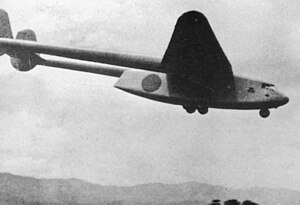Loading AI tools
Japanese experimental military glider From Wikipedia, the free encyclopedia
The Kokusai Ku-7 Manazuru (真鶴 "white-naped crane"; Allied code-name Buzzard) was a large experimental twin boom Japanese military glider.
| Ku-7 Manazuru Ki-105 Otori | |
|---|---|
 | |
| General information | |
| Type | Transport glider (Ku-7) Transport aircraft (Ki-105) |
| National origin | Japan |
| Manufacturer | Kokusai |
| Number built | 2[1] |
| History | |
| First flight | 1942 |
| Variants | Kokusai Ki-105 |
An enlarged version of the earlier Maeda Ku-1 glider, it was developed during 1942. The use of a twin boom design allowed for a large square cargo door, which meant that the aircraft was capable of carrying either 32 soldiers, 7600 kg of cargo or even a light tank. It required a powerful towing aircraft, either the Nakajima Ki-49 or the Mitsubishi Ki-67, which were in short supply. As a result, the aircraft were modified by fitting them with engines, which were designated the Ki-105 Otori (鳳 "Phoenix").[2] Intended for use as fuel transports, only nine, of 300 ordered, were produced before development priorities were shifted elsewhere.[3]
Data from Encyklopedia Uzbrojenia,[4] Japanese Aircraft of the Pacific War[3]
General characteristics
Performance
Aircraft of comparable role, configuration, and era
Seamless Wikipedia browsing. On steroids.
Every time you click a link to Wikipedia, Wiktionary or Wikiquote in your browser's search results, it will show the modern Wikiwand interface.
Wikiwand extension is a five stars, simple, with minimum permission required to keep your browsing private, safe and transparent.